Licence to change: The challenge of modernising 007 for a post-MeToo, post-Covid world
With the release of the new Bond film ‘No Time to Die’ later this month – 60 years after the announcement of Sean Connery as the first ever 007 – Geoffrey Macnab looks at how all the Bonds were chosen, and what challenges the producers now face in finding a successor to Daniel Craig

He has “anthracite eyes”, “a road driller’s biceps”, the “brooding power of Marlon Brando”, and the “faintly arrogant charm that was the lethal chemistry of the late Errol Flynn”. This was how a very shaken and stirred Daily Mirror journalist reacted to the casting of Sean Connery as James Bond.
It’s 60 years now since the then 31-year-old Scottish actor signed on to play the main role in the new series of James Bond films in November 1961. He was to be paid a modest fee of £6,000 for Dr No, which was to start shooting in Jamaica early the following year.
From the outset, Connery’s Bond was incorrigible, chatting up Miss Moneypenny (Lois Maxwell) and then refusing to take her to dinner (“M would have me court-martialled for misuse of government property”), flirting outrageously, firing off double entendres and insisting throughout that his intentions were “strictly honourable” when they were so obviously quite the reverse. At moments of maximum danger, he always had that glint in his eye and he was still an inveterate snob. When the henchmen of Dr No (Joseph Wiseman) apprehend him, he famously grabs a bottle from the table to protect himself. “That’s a Dom Perignon ’55. It would be a pity to break it,” Dr No chides him. “I prefer the ’53 myself,” Bond engages in his usual one-upmanship.
The story of Connery’s casting as Bond has long since passed into movie myth. This was a Cinderella-like process in which lots of ugly sisters were also vying for the role before producer Cubby Broccoli decided that Connery was the perfect fit.
The dapper David Niven, who was later to star in the 1967 Bond spoof Casino Royale, swarthy Trevor Howard, cerebral Michael Redgrave, and debonair Cary Grant were other prime candidates. Broccoli and his fellow producer Harry Saltzman refused to countenance the idea of an American in the role. Bond author Ian Fleming was keen on Roger Moore – soon to star in TV’s The Saint. But Broccoli felt he was “slightly too young” and “a shade too pretty”. He’d change his mind a decade later when Moore played Bond in 1973’s Live and Let Die.
Patrick McGoohan and James Fox pulled out of the race to play Bond because of religious scruples and an aversion to the sex and violence. The saturnine Welsh actor Stanley Baker didn’t want to commit to three films.
“To be candid, all the British actors I had interviewed lacked the degree of masculinity Bond demanded,” the producer later stated, claiming that “only Sean had the balls for the part”.
Broccoli had first noticed Connery opposite Lana Turner, “projecting a kind of animal virility” in Lewis Allen’s 1958 romantic drama, Another Time, Another Place, in which Connery played a BBC correspondent who had an affair with an American journalist. As the producer noted in his autobiography, Connery was tall, with a commanding physical presence and “just the right hint of threat behind that hard smile and faint Scottish burr”. Broccoli later saw Connery in Disney movie Darby O’Gill and the Little People (1959) and, by then, not even the leprechauns could put him off.
Broccoli’s wife Dana confirmed his hunch that Connery was indeed an “uncut diamond” with proper sex appeal. “That’s our Bond!” she told him definitively.

Watch Apple TV+ free for 7 day
New subscribers only. £9.99/mo. after free trial. Plan auto-renews until cancelled.
ADVERTISEMENT. If you sign up to this service we will earn commission. This revenue helps to fund journalism across The Independent.

Watch Apple TV+ free for 7 day
New subscribers only. £9.99/mo. after free trial. Plan auto-renews until cancelled.
ADVERTISEMENT. If you sign up to this service we will earn commission. This revenue helps to fund journalism across The Independent.
Now, the Bond producers will be looking for another uncut diamond to take over the role in one of the most lucrative franchises in film history. Daniel Craig has already long since announced he is stepping down as 007 with No Time to Die – which is released on 30 September – as his swansong.

If it was tough finding a Bond in 1961, it will be near impossible to cast the role satisfactorily in 2021. On the one hand, current Bond producers Barbara Broccoli and Michael G Wilson will be trying to stay true to the spy hero created by Fleming. On the other, they will surely want to reflect the immense cultural changes since Connery first starred as 007. The challenge lies in modernising 007 for a post-MeToo, post-Covid world without straining away the qualities that define the character.
You need only look at the bookmakers’ odds for the next Bond to realise how confused we’ve all become about what Bond should represent in 2021 and beyond. Everyone seems to be in the mix. Tom Hardy, better known for playing villains and gangsters than heroes, is among the favourites. So is Regé-Jean Page from stylised costume drama Bridgeton. Luke Evans, James Norton, Tom Hiddleston, Idris Elba and Richard Madden are in the chasing pack. You can get long shots such as Robbie Williams and Prince Harry at 500-1.
“With Bond, it could be a man or woman. They could be white, black, Asian, mixed race. They could be young or old,” Lashana Lynch, co-star of No Time to Die and herself among the favourites to be the first female 007, told The Guardian last week.
Some are anticipating that the Bond producers will take a very radical leap with the character who has been nurtured through 25 features already. After all, Amazon Studios recently bought MGM, the studio behind the Bond franchise.
Is it time to customise the UK’s best known spy for Amazon Prime, to take him out of the cinemas and re-package the franchise for the video on demand era? No Time to Die could have reached audiences almost two years ago if it hadn’t been for Covid. Apple reportedly considered an offer of around $400m for the streaming rights and Netflix was also strongly interested but the producers insisted on a full theatrical release. The result has been an unprecedented five year wait for the new Bond, a delay which has cost a fortune at a time when other blockbusters have been made available on VOD. With Covid still eating away at cinema receipts, No Time to Die will struggle to emulate the box office performance of Spectre let alone the billion dollar haul achieved by Skyfall.

But doesn’t this upheaval in the global film business provide the perfect opportunity to rethink everything about Bond from his gender to his ethnic background, from his drinking habits to his sexual preferences and his carbon footprint? Is it an opportunity to give him a testosterone bypass?
Bond as described by Fleming was a public school boy who came from a world of privilege. He was expelled from Eton after having an affair with a maid. He had “dark, cruel good looks” which made women tremble. He wore silk shirts and cotton pyjamas.
“[Bond] is quiet, hard, ruthless, sardonic, fatalistic… he likes gambling, golf and fast motor cars,” Fleming wrote in a memorandum about the character he sent Broccoli.
Fleming’s Bond was also “tough and modern”, with a healthy disrespect for authority. On screen, he was a departure from the patrician world of British cinema of the time in which everyone slapped each other on the back – the “old boy mentality”. He may have been from a privileged, upper-class background but he had something in common with the insubordinate and rebellious heroes from other films of the era like Room at the Top and Saturday Night and Sunday Morning. In casting a working-class Scot like Connery, Broccoli talked of giving a “coarser shading” to the public school boy character that Fleming had created while remaining true to his essence.
There is a sense, though, that Bond changed Connery far more than Connery changed Bond. He was the Eliza Doolittle figure and the first Bond director Terence Young was his Henry Higgins-like mentor. Collaborators recall how patiently Young groomed Connery. He took the Scottish actor both to his Savile Row tailors and to his favourite restaurants. Young taught Connery that you don’t drink red wine with the fish. Young gave him the taste for caviar and helped him distinguish between different champagne vintages.

The director had worked with Connery before on the 1957 thriller Action of the Tiger, and initially felt casting him as Bond was a “disastrous” move. However, Young took him in hand. “Sean was a pretty rough diamond at that time. And Terence taught him everything he knew,” legendary Bond production designer Ken Adam later claimed. Connery’s swagger and style in the role came from his director.
The casting process for actors in Bond movies today seemingly remains much the same as it always has been. Aspiring 007s have to prove that they cut it both as lovers and killers. When George Lazenby was auditioning to replace Connery in On Her Majesty’s Secret Service, 1969, the producers filmed a series of test fight sequences to see how he coped as “an action man”. Actor Lynch said she was put through very similar stunt tests in her audition for No Time to Die, in which she plays Nomi, an MI6 agent. “They hand you a bunch of weapons and they teach you a routine for a few seconds or a minute and then you basically have to copy the routine.”
With Lazenby, the “infallible litmus test” was “to parade him in front of the office secretaries”. When their eyes all lit up, Broccoli knew they had their man. In 2021, one guesses that the Bond producers will be looking at social media reactions rather than swooning secretaries before they anoint the next 007. However, they have a history of going against the grain. They chose Craig as Bond in Casino Royale, in 2006, one of the darkest, most intense films in the series, at a time when their own research suggested audiences still wanted “gadgets, Bond girls, one-liners, Q and Moneypenny”.
“The enemy is repetition and laziness, and the great danger is not challenging the pre-existing format,” director Sam Mendes told film trade publication Deadline after making Skyfall , 2012, and Spectre, 2015. “You have to be as brave as when they cast Daniel [Craig], and when they let M die. They have to go off in a completely different direction, into regenerating mythology. You cast a new actor and find a new director, and make something totally new.”
These were stirring words but they were also fanciful. You can’t simply ditch the pre-existing format because that is the basis of the franchise. The search for the perfect Bond, therefore, remains a never-ending quest that always ultimately ends in anticlimax. Either the audiences will tire of the actor or the actor will tire of the role. Connery wearied of it and so has Craig.

Actors who long to play Bond know deep down that it is a dead end. It brings immense riches and global celebrity but allows little space in which to develop a character. They can swing a little darker and more morose (007 as portrayed by Craig or Timothy Dalton) or show off their suave and comic side (as Moore and Pierce Brosnan did so effectively). Ultimately, it makes little difference. Bond remains an enigma. You can’t sketch in too much of his backstory or private life because that risks reducing him to just another screen character. His inscrutability enables audiences to regard him in whichever way they want. He is fascinatingly one-dimensional. Regardless of who plays him now – if it remains a “him” – he will still be the same “blunt instrument wielded by a government department” as Fleming once described him.
The world is waiting to see what the producers will do with the character after No Time to Die. They are likely to be bold and the media will doubtless applaud them for their new thinking about one of cinema’s most revered secret agents. Nonetheless, when Bond 26 rolls around in a year or two, it will almost certainly be more of the same. Whichever actor is chosen, he or she be will be taken in hand and taught how to be Bond, just as Connery was by director Young six decades ago. 007 may have a licence to kill but he doesn’t have a licence to change.
‘No Time to Die’ is released on 30 September
Join our commenting forum
Join thought-provoking conversations, follow other Independent readers and see their replies
Comments


Bookmark popover
Removed from bookmarks